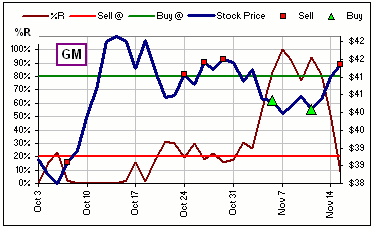| Williams %R |
When buying and selling stock the principle rule is to Buy Low, Sell High.
>Brilliant! Is that idea yours?
Pay attention.
The questions become:
- Low compared to what?
- High compared to what?
One that I never heard of is Williams %R (named after Larry Williams). I was, however, surprised to find that it's just the stochastic oscillator ... but upside down?
>Huh?
Williams %R says:
- Low compared to the lowest price over the past N days.
- High compared to the highest price over the past N days.
 Williams %R |
Williams measures the current price on a scale running down from the highest to the lowest price.
%R = 100(High - Price) / (High - Low) |
- When %R is close to 100%, the price is close to the Low over the past N days.
- When %R is close to 0%, the price is close to the High over the past N days.
- Buy when %R is close to 100%
- Sell when %R is close to 0%
|
>And that stochastic thing?
That puts the current price on a scale running up from the lowest to the highest price (over the past N days). %K = 100(Price - Low) / (High - Low) |  Stochastic oscillator |
>Buy and Sell signals?
Yes. When %R is less than, say 20%, then Buy and ...
>When it's above, say 80%, then Sell. Right?
You got it.
Here's an example (using daily General Motors prices over the past few months) 
There are:
|  Willimas %R for Microsoft |
To download a .ZIPd spreadsheet which does this sort of thing, RIGHT-click
here and Save target file
... but don't expect miracles 
